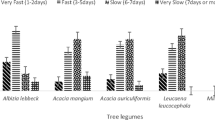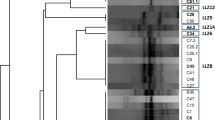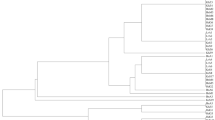Abstract
Indigenous rhizobia were isolated from root nodules of lentil plants collected from various agro-climatic regions of India. These isolates together with four standard lentil Rhizobium strains were screened for sensitivity against eight phages. Four strains, USDA 2431, BHULR 104, BHULR 113 and BHULR 115 having restricted sensitivity to lytic phages LRP-1, LRP-4, LRP-13 and LRP-15 respectively, were characterized for both physiological and molecular characters. All strains had a generation time of between 3.8 and 5.6 h in yeast extract–mannitol (YM) broth, and colonies on YM agar plates showed an acidic reaction. Compared to other strains, strain USDA 2431 grew poorly when sucrose was the sole carbon source and showed maximum growth in arabinose-containing medium. The intrinsic antibiotic resistance level in all strains was tested against seven antibiotics and found to be high with ampicillin and kanamycin (50–60 μg ml-1) but very low with neomycin (0.03 μg ml-1). With the exception of strain BHULR 113, all strains expressed ex planta nitrogenase activity, with strain USDA 2431 showing the maximum activity (26.8 nmol C2H4 h-1 mg-1 protein) after 6 h of incubation. Genomic and phylogenetic relationships among the strains were examined by randomly amplified polymorphic DNA and 16S rRNA sequence analysis. Genetic distance varied from 0.09 to 0.23 among the strains, and the primer OPL-11 was found to be suitable for the discrimination of these strains. The 16S rRNA sequence analysis revealed 99–100% similarity with Rhizobium leguminosarum bv. viciae. These results clearly indicate that phage sensitivity is a useful marker for discriminating locally soil-adapted rhizobial strains forming effective nodules in lentil.


Similar content being viewed by others
References
Andersson AF, Banfield JF (2008) Virus population dynamics and acquired virus resistance in natural microbial communities. Science 320:1047–1050
Appunu C, Dhar B (2006) Phage typing of indigenous soybean-rhizobia and relationship of a phage group strains for their asymbiotic and symbiotic nitrogen fixation. Indian J Exp Biol 44:1006–1011
Arrese-Igor C, Estavillo JM, Peńa JI, Gonazalez-Murua G, Aparicio-Tejo PM (1989) Effect of low nitrate supply on nitrogen fixation in alfalfa root nodules induced by Rhizobium meliloti strains with varied nitrate reductase activity. J Plant Physiol 135:207–211
Athar M (1998) Drought tolerance by lentil rhizobia (Rhizobium leguminosarum) from arid and semiarid areas of Pakistan. Lett Appl Microbiol 26:38–42
Ausubel FM, Roger B, Kingston RE, Moore DD, Seidman JG, Smith JA, Struhl (eds) (1994) Current protocols in molecular biology. John Wiley and Sons, New York
Bell T, Newman JA, Silverman BW, Turner SL, Lilley AK (2005) The contribution of species richness and composition to bacterial services. Nature 436:1157
Beynon JL, Josey DP (1980) Demonstration of heterogeneity in a natural population of Rhizobium phaseoli using variation in intrinsic antibiotic resistance. J Gen Microbiol 118:437–442
Bremer E, Kessel C, Nelson L, Rennie RJ, Rennie DA (1990) Selection of Rhizobium leguminosarum strains for lentil (Lens culinaris) under growth room and field conditions. Plant Soil 121:47–56
Dhar B, Ramkrishna K (1987) Morphology and general characteristics of phages of chickpea rhizobia. Arch Microbiol 147(2):121–125
Dhar B, Singh BD, Singh RB, Srivastava JS, Singh VP, Singh RM (1979) Occurrence and distribution of rhizobiophages in Indian soils. Acta Microbiol Pol 28(4):319–324
Dhar B, Upadhyay KK, Singh RM (1993) Isolation and characterization of bacteriophages specific for Rhizobium leguminosarum bivor phaseoli. Can J Microbiol 39:775–779
Dooley JJ, Harrison SP, Mytton LR, Dye M, Cresswell A, Skot L, Beeching JR (1993) Phylogenetic grouping and identification of Rhizobium isolates on the basis of random amplified polymorphic DNA profiles. Can J Microbiol 39:665–673
Eaglesham ARJ (1987) The use of intrinsic antibiotic resistance for Rhizobium study. In: Elkan GH (ed) Symbiotic nitrogen fixation technology. Dekker, New York, pp 185–204
Giannakis C, Nicholas DJD, Wallace W (1988) Utilization of nitrate by bacteroids of Bradyrhizobium japonicum in the soybean root nodule. Planta 174:51–58
Glenn AR, Dilworth MJ (1981) The uptake and hydrolysis of disaccharides by fast and slow growing species of Rhizobium. Arch Microbiol 129:233–239
Jaiswal SK, Dhar B (2010) Morphology and general characteristics of phage specific to Lens culinaris rhizobia. Biol Fertil Soils 46:681–687
Jaiswal SK, Dhar B (2011) Identification and assessment of symbiotic effectiveness of phage-typed Rhizobium leguminosarum strains on lentil (Lens culinaris Medik) cultivars. Curr Microbiol 62:1503–1509
Kaneshiro T, Cromwell CD, Hanrahan RF Jr (1978) Acetylene reduction activity in free-living cultures of Rhizobia. Int J Syst Bacteriol 28:27–31
Kurz WGW, La Rue TA (1975) Nitrogenase activity in Rhizobia in absence of plant host. Nature 256:407–408
Lesley SM (1982) A bacteriophage typing system for Rhizobium meliloti. Can J Microbiol 28:180–189
Lindstrom EK, Jarvis BDW, Lindstrom PE, Patel JJ (1983) DNA homology, phage-typing and cross-nodulation studies of rhizobia infecting Galegae species. Can J Microbiol 29:781–789
Lindstrom K, Lipsanen P, Kaijalainen S (1990) Stability of markers used for identification of two Rhizobium galgae inoculant strains after five years in the field. Appl Environ Microbiol 56:444–450
Lowry OH, Rosebrough NJ, Farr AL, Randall RJ (1951) Protein measurement with Folin-phenol reagent. J Biol Chem 193:265–275
Maheshwari DK, Saraf M (1994) Effect of carbaryl and 2,4-D to nitrogenase and uptake hydrogenase in agar cultures and root nodules formed by Rhizobium leguminosarum. J Gen Appl Microbiol 40:569–574
Manhart JR, Wong PP (1979) Nitrate reductase activity of rhizobia and the correlation between nitrate reduction and nitrogen fixation. Can J Microbiol 25:1169–1174
McComb JA, Elliott J, Dilworth MJ (1975) Acetylene reduction by Rhizobia in pure culture. Nature 256:409–410
McNeil DL, Hill GD, Materne M, McKenzie BA (2007) Global production and world trade. In: Yadav SS, McNeil D, Stevenson PC (eds): lentil: an ancient crop for modern times. Kluwer, Dordrecht, pp. 95–106
Mendum TA, Clark IM, Hirsch PR (2001) Characterization of two novel Rhizobium leguminosarum bacteriophages from a field release site of genetically-modified rhizobia. Antonie van Leeuwenhock 79:189–197
Monza J, Delgado MJ, Bedmar EJ (1992) Nitrate reductase and nitrite reductase activity in free-liing cells and bacteroids of Rhizobium loti. Plant Soil 139:203–207
O’Gara F, Shanmugam KT (1976) Control of symbiotic nitrogen fixation in rhizobia. Regulation of NH4 + assimilation. Biochem Biophys Acta 451:342–352
Pagan JD, Child JJ, Scowcroft WR, Gibson AH (1975) Nitrogen fixation by Rhizobium cultured on a defined medium. Nature 256:406–407
Shah NH, Hafeez FY, Hussain A, Malik KA (1996) Influence of seasonal variation on the indigenous population of Rhizobium leguminosarum bv. viciae and competitive ability of introduced rhizobia in lentil. LENS Newsl 23:32–37
Sontheimer EJ, Marrafini LA (2010) Slicer for DNA. Nature 468:45–46
Stam H, van Verseveld HW, Stouthamer AH (1983) De-repression of Nitrogenase in chemostat cultures of fast growing Rhizobium leguminosarum. Arch Microbiol 135:199–204
Staniewski R (1970) Typing of Rhizobium by phages. Can J Microbiol 16:1003–1009
Subba Rao NS (1976) Field response of legumes in India to inoculation and fertilizer application. In: Nutman PS (ed) Symbiotic nitrogen fixation in plants. International Biological Programme, vol. 7. Cambridge University Press, London, pp 255–268
Vincent JM (1970) A manual for the practical study of root nodule bacteria. IBP handbook No. 15. Blackwell Scientific, Oxford and Edinburgh
Vincent JM (1974) Root nodule symbiosis with Rhizobium. In: Quispel A (ed) The biology of nitrogen fixation. North Holland Research Monographs, Frontiers of Biology, vol. 33. North Holland, Amsterdam
Vos M, Birkett PJ, Birch E, Griffiths RI, Buckling A (2009) Local adaptation of bacteriophages to their bacterial hosts in soil. Science 325:833
Yao ZY, Kan FL, Wang ET, Wei GH, Chen WX (2002) Characterization of rhizobia that nodulate legume species of the genus Lespedeza and description of Bradyrhizobium yuanmingense sp. nov. Int J Syst Evol Microbiol 52:2219–2230
Acknowledgements
The work was completed with the financial support of the Department of Biotechnology, Ministry of Science and Technology, Govt. of India. We thank Prof. A. Vaishampayan for help in discussion and suggestions in the manuscript
Author information
Authors and Affiliations
Corresponding author
Rights and permissions
About this article
Cite this article
Jaiswal, S.K., Dhar, B. & Rai, A.K. Physiological and molecular characterization of locally adapted Rhizobium strains of lentil (Lens culinaris Medik.) having restricted phage sensitivity. Ann Microbiol 62, 1453–1459 (2012). https://doi.org/10.1007/s13213-011-0398-z
Received:
Accepted:
Published:
Issue Date:
DOI: https://doi.org/10.1007/s13213-011-0398-z




